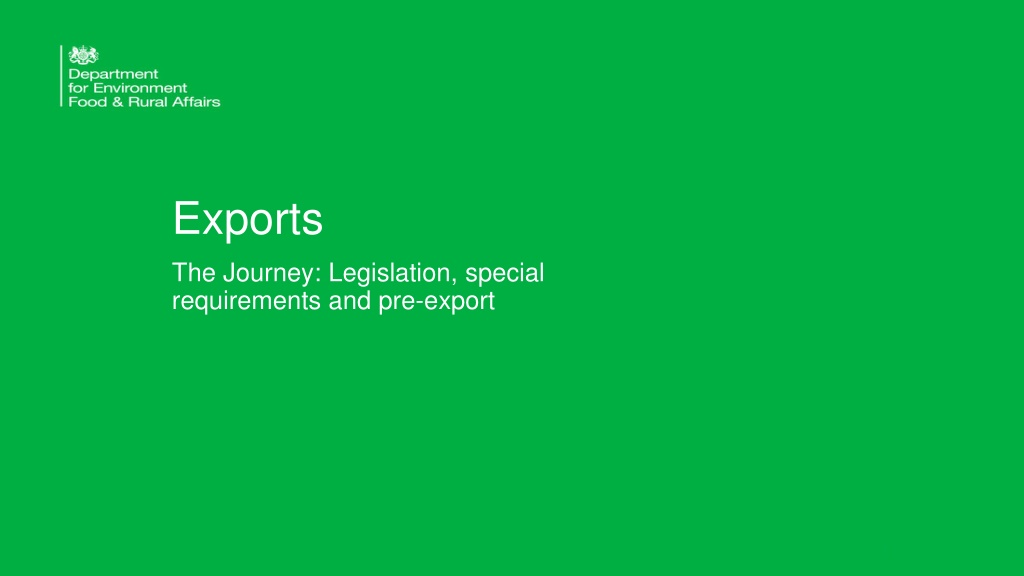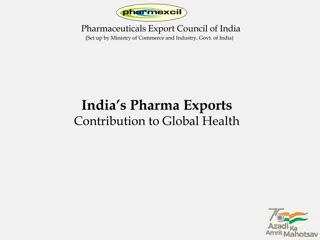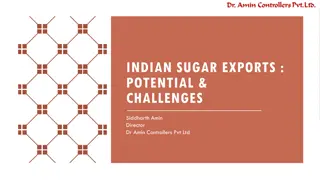Understanding EU Legislation for Plant Health Exports
This module explores the EU legislation governing plant health exports, covering legislative principles, export preparation steps, and import requirements. It emphasizes the importance of preventing the introduction and spread of harmful organisms, facilitating international trade, and complying with fundamental IPPC rules for export to the EU.
Download Presentation

Please find below an Image/Link to download the presentation.
The content on the website is provided AS IS for your information and personal use only. It may not be sold, licensed, or shared on other websites without obtaining consent from the author. Download presentation by click this link. If you encounter any issues during the download, it is possible that the publisher has removed the file from their server.
E N D
Presentation Transcript
Exports The Journey: Legislation, special requirements and pre-export 1
Content This module will cover the basic principles of the current EU legislation that covers plant health as well as where to find any emergency or official notifications to any changes in the EU s import requirements. It will also look at the first steps in the export journey and what you need to do to prepare for an export.
International plant health learning objectives Understand: Legislative purpose and principles What goods don t require a Phytosanitary Certificate (PC) Which pieces of legislation can be used to determine the import requirements of the EU.
Export Journeys Pre Export: Do my goods need a phytosanitary certificate What are the import requirements Do I need laboratory tests or growing season inspections Pre Export How do I know if a PC is required for my goods to be exported to the EU or NI What legislation do I need to be aware of and how do I interpret it What are the import requirements Do I need any further lab tests or growing season inspections before my export inspection Requirements PHSI or CIT verify the importing country s requirements This will include any current prohibitions Verification 4
Legislation - Purpose To prevent the introduction into of organisms harmful to plants and plant products and to prevent their spread within a country. In order to protect agriculture and the environment and to facilitate international trade of plant and plant products 5
Fundamental Requirements Under IPPC rules any controls must be: Technically justified - normally this is done by completing Pest Risk Analysis (PRA). A PRA is an evaluation of evidence to determine whether an organism is a pest and whether it should be regulated and if so the strength of any phytosanitary measures to be taken. Uniform - by following internationally agreed definitions under International Plant Protection Convention (IPPC) and internal Standard Operating Procedures (SOPs) Transparent - by the publication of import standards (legislation) To be able to export goods to the EU you will have to know which EU legislation is applicable and where to look up requirements.
EU Legislative Structure Smarter Rules for Safer Food (SRSF) The SRSF package includes 3 principal EU regulations, each piece of legislation listed below will also contain various implementing and delegated acts that provide further detailed information about a particular area: Official Controls Regulation (EU) 2017/625: how controls across the agri- food chain will be monitored and enforced Plant Health Regulation (EU) 2016/2031: controls for protecting plants from disease and pests Animal Health Regulation (EU) 2016/429: a framework for the principles of European animal health The new Plant Health and Official Controls Regulations, became applicable on 14 December 2019 and collectively replaced a number of existing regulations, which modernised and improved plant health controls. These regulations, which apply across the EU. 7
Extended scope of phytosanitary certificate (PC) requirements With the introduction of the new Plant Health Regulation (PHR) and its accompanying acts it meant that the scope of the goods requiring a PC significantly increased. PCs now needed for almost all plants and living parts of plants, including seeds intended for planting. Exemptions Only five tropical fruits do not require a PC: Pineapple Coconut Durian Banana (Musa sp.) Dates
EU Legislative Structure Smarter Rules for Safer Food (SRSF) For phytosanitary requirements there are also a few other pieces of legislation that you will need to be aware of for exports: Phytosanitary Conditions Regulation (PCR) 2019/2072 Emergency Measures What is an Emergency Measure Where the EU has justified grounds and as a matter of urgency need to address a serious pest risk the EU can adopt measures to implement the necessary risk mitigation measures in a harmonised manner at the Union level. This enables the EU to react fast to new and novel pests diseases without having to go through the full legislative process. They often tend to be time limited and any measures need to be justified. Emergency Measures can be implemented at any time, so exporters need to be aware of any changes of legislation, as it may affect certain commodities that are exported. 9
EU Legislative Structure Emergency Measures There are several ways to stay up-to-date with EU emergency measures: Current Emergency Measures can be found the EU s website (you need to read each one to determine which goods it applies to) Sign up to the EU s official journal and sign up for notifications. Where possible you should always use a consolidated version Review WTO notifications via ePing 10
EU Legislative Structure Phytosanitary Conditions Regulation (PCR) 2019/2072 The PCR contains most of the requirements needed to exports goods to the EU and includes: A list of all the quarantine pests and diseases What goods require a PC and pre-notification Whether any goods have special requirements that need to be met A list of EU Member States (MS) that have protected zone status. The PCR can be found by Googling 2019/2072 or from the EU s website The PCR is updated to take into account new quarantine pests and diseases as well as new special requirements. The next slide will show all the annexes in the PCR, which you should have some working knowledge of but also the key Annexes that details the EU s import requirements, which you will have to know how to navigate to find out if goods are eligible for exports. 11
PCR - Annexes Annex Common Description I Definitions II List of Union quarantine pests III List of protected zones and their quarantine Pests IV List of Regulated Non-Quarantine Pests (RNQPs) and their hosts V measures to prevent the presence of RNQPs VI Prohibitions VII Special requirements for goods being imported to the EU VIII Special requirements for goods originating in the EU IX List of plants and plant products prohibited from entering protected zones X Special requirements for certain goods moving into protected zones XI Part A Which goods require a PC and pre-notification Part B Which goods require a PC Part C Which goods do not require a PC Bold denotes relevance for exports 12
PCR - Annexes Annex Common Description XII List of goods that require a PC for introduction into a PZ from certain countries XIII What goods require a plant passport XIV What goods require a PZ plant passport All fruit, vegetables and cut flowers will require a PC, as stated by Annex XI Part A and Part B. (except for those 5 fruits mentioned in Part C) This means that all goods being exported to the EU will require a phytosanitary inspection. Note: All goods and pests will be referenced by their scientific names in Latin. You may have to Google their name, to know what it is. The scientific name will be required on the PC. Malus = Apples Pyrus = Pears Rubus = Raspberries 13
Knowledge Test Please visit the below link to complete the knowledge test for this module: PHEATS Legislation, special requirements and pre-export https://forms.office.com/Pages/ResponsePage.aspx?id=UCQKdycCYkyQx044U38RAvJ7GY98IcdOvJfSZ- UDeKFUQzlZV1QyMjJWVTdMNTNYNTlEWERLMlBBRy4u 15























